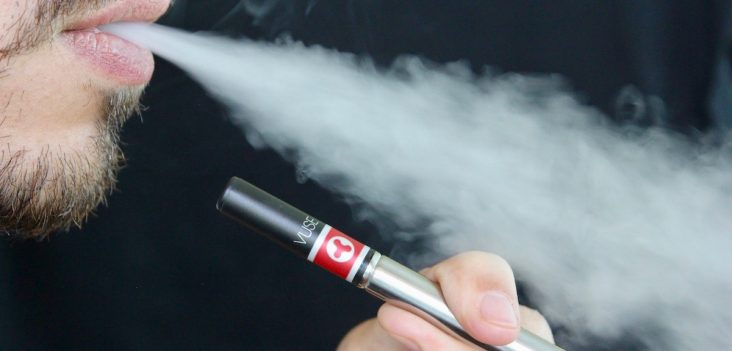Study finds link between vaping, respiratory illnesses
by December 18, 2019 3:38 pm 1,040 views

The first study on the long-term effects of vaping shows a link between it and respiratory illnesses, while another study found 12% of young people self-reported vaping in the last 30 days. Both were released Monday (Dec. 16).
The longitudinal study of more than 32,000 adults using data collected from 2013-16 found e-cigarette users were 29% more likely to report having a respiratory illness by October 2016 after reporting having no diseases from September 2013 to December 2014. Former users were 31% more likely to suffer from one of those diseases.
Those diseases were chronic obstructive pulmonary disease, chronic bronchitis, emphysema and asthma.
They differ from e-cigarette or vaping associated lung injury, or EVALI, the acute illness associated with vaping that has resulted in 52 deaths, the Centers for Disease Control and Prevention has reported.
The study, “Association of E-Cigarette Use With Respiratory Disease Among Adults: A Longitudinal Analysis,” was published in the American Journal of Preventive Medicine. The authors were Dharma N. Bhatta, PhD, MPH; and Stanton A. Glanz, PhD, of the University of California San Francisco Center for Tobacco Control Research and Education.
“E-cigarette use predicted the development of lung disease over a very short period of time. It only took three years,” Glantz told NBC News.
Current combustible tobacco users were 2.5 times as likely to have developed one of those diseases over that time period. Former combustible tobacco users were 16% more likely.
Fifteen percent of respondents, or 5,466, said they had a respiratory disease when the study started.
The study’s findings suggested that switching from combustible tobacco to e-cigarettes could reduce the risk of developing one of those respiratory illnesses. However, most of the e-cigarette users also used combustible tobacco, and the use of both products increased the overall risk.
The study was divided into three “waves.” Wave 1 covered September 2013 to December 2014, Wave 2 from October 2014 to October 2015, and Wave 3 from October 2015 to October 2016. In Wave 3, 91.2% of e-cigarette users also used combustible tobacco, and 64.9% smoked cigarettes.
Users of both products were 3.3 times more likely to develop a respiratory illness than those who had never smoked or vaped.
“In other words, dual use of e-cigarettes and combustible tobacco (including cigarettes) is more dangerous than using either product alone,” the study reported.
Another study released Monday found that 12% of eighth, 10th and 12th grade students in 2017 reported using an e-cigarette in the past 30 days. Current cigarette smokers, marijuana users, 10th and 12th graders, and male students reported higher vaping rates. Nearly 30% of students who had vaped in the last 30 days reported vaping marijuana. Black, non-Hispanic students were less likely to report vaping than white, non-Hispanic students.
That study was conducted by the University of Nebraska Medical Center College of Public Health’s Hongying Dai, PhD, and Mohammad Siahpush, PhD.
Dr. Joe Thompson, director of the Arkansas Center for Health Improvement, a nonpartisan, independent health policy center, said one pod of Juul, the vaping industry’s leading provider, has as much nicotine as a pack of cigarettes. Therefore, users can increase their nicotine addiction by using vaping products.
“I think what youth don’t recognize and parents don’t understand is that the industry has introduced new nicotine delivering devices that are even more effective at delivering nicotine than a cigarette is, and it’s the nicotine that causes the addiction that then causes individuals to be lifelong consumers of those products,” he said.
The study’s finding of 12% use among students is considerably less than the National Tobacco Youth Survey’s recent finding that 27.5% of high school students had used an e-cigarette in the past 30 days, while 10.5% of middle school students were current users. The findings were released in November by the Food and Drug Administration and the Centers for Disease Control and Prevention.
Meanwhile, an Arkansas Prevention Needs Assessment survey by the Division of Behavioral Health Services found that 44% of the state’s high school seniors reported having tried e-cigarettes.
The budget deal reached between President Trump’s administration and congressional lawmakers includes an increase in the minimum age to purchase tobacco and vaping products from 18 to 21. Arkansas raised its minimum tobacco and vaping age to 21 earlier this year.
Thompson said under 21 restrictions should be enforced at purchasing. He said e-cigarette products should be taxed at the same rate as traditional tobacco products, and advertising should be restricted near schools and youth hangouts.
